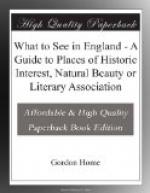But though the monastery itself was destroyed, the outer walls of the noble church remain, together with a great portion of the massive central tower, the choir chapels, and the east end, with its delicate lancet-windows. The clerestory, with its Norman windows, is also intact on both sides of the nave, and between the columns are remains of the screen which once shut off the eastern aisle. The door on the south side leading to the dormitories of the monks may still be traced.
The ruins of the chapter-house are remarkably fine, and in good preservation, with a beautiful early Gothic groined roof. Beyond the chapter-house are the refectory and kitchen, and on the side next to the river were the cloisters. In the outer court of the abbey stood the lodge, and there was formerly a fine gatehouse, which collapsed in 1828, and is now almost entirely gone.
The brook, that once flowed across the abbey court, still works the mill close by; but the fine old bridge over the Severn, built by the monks, was taken down in 1690.
A good way of seeing Buildwas is to go there from Shrewsbury by an early train, walking to Leighton and Eaton Constantine, both charming villages, and rejoining the train at Cressage for Shrewsbury. An alternative route is from Shrewsbury to Much Wenlock, where there are the ruins of a fine Abbey.
[Illustration: Photochrom Co., Ltd.
BUILDWAS ABBEY.
The ruins of the Church. This was one of the oldest Cistercian monasteries in England.]
LUDLOW AND ITS CASTLE
=How to get there.=—Train from Paddington. Great Western Rly. =Nearest Station.=—Ludlow. =Distance from London.=—162 miles. =Average Time.=—Varies between 4-1/2 to 7 hours.
1st
2nd 3rd
=Fares.=—Single 24s. 4d. 15s. 6d. 12s.
4-1/2d.
Return
43s. 4d. 27s. 2d. 24s. 9d.
=Accommodation Obtainable.=—“The
Feathers Hotel,” “Angel
Hotel,” etc.
=Alternative Route.=—Train from Euston.
L. and N.W. Railway.
Beautifully situated in a lovely valley surrounded by wooded hills, Ludlow presents a picture of an ancient but prosperous city. The town is placed at the meeting of two small rivers, the Teme and Corve, which flow into the Severn. On the top of a hill in the western part of the town is the old castle, which was a royal residence from early times. It was built at the time of the Conquest, and was the most important of all the castles that guarded the Welsh border. The eldest son of Edward IV. lived in the castle under the guardianship of his uncle, Lord Rivers, and he was proclaimed king there when only twelve years old. Prince Arthur, the first husband of Katharine of Aragon, and the eldest son of Henry VII., was also brought up and educated in the castle. In the Civil War the Parliamentary troops partially destroyed the castle, but it was not until the reign of George I. that the buildings were unroofed for the sake of their lead.




